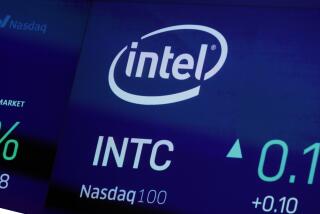Pentium II: Intel Runs a Tight Chip
- Share via
Intel Corp. is scheduled to roll out a new version of its Pentium II computer chip today that is less remarkable for how fast it goes than for how densely and delicately it is built.
The processor is the first in the Santa Clara, Calif., company’s flagship line to be born of a massive expansion and overhaul of Intel’s fabrication plants in recent years. That revamping enabled Intel to reach a new milestone in shrinking the circuitry of microprocessors.
The chip’s clock speed is rated at 333 megahertz, making it about 10% faster than previous versions. More important, the tiny “wires” that connect the transistors on the chip measure just 0.25 micron across, roughly 1/400th the thickness of a human hair. The previous standard was 0.35 micron.
Shrinking the circuitry--something that happens only every two or three years--is important to both performance and production.
Because the wires are thinner and tighter, electricity flows faster, less energy is used and less heat dissipated. That will help drive new advances in chips, enabling Intel to deliver models capable of speeds up to 450 MHz by the end of the year, said company spokesman Howard High.
Energy efficiencies also help the new chips perform better in laptops, where battery power is limited and tight quarters make it tough to keep chips cool. Intel said it plans to introduce the first Pentium II chip for laptops later this year.
In terms of production, shrinking the circuits simply means more transistors can be packed in less space, enabling Intel to double the number of chips taken from each wafer, a round plate of silicon from which processors are cut like cookies.
But in pushing the limits of speed and performance, analysts say, Intel seems to be getting ahead of consumer demand, because few people really need the kind of performance the new chips deliver.
For most users, “today’s low-end processors and year-old technology are more than adequate,” said Kevin Hause, an analyst at International Data Corp. in Mountain View, Calif.
That doesn’t mean the market for high-end chips is drying up, Hause said, but it could shrink as it migrates from the mainstream to more specialized applications.
Last year’s processors are more than good enough for word-processing and even Web-surfing, Hause said. But the new chips help plow through power-hungry tasks such as image-editing, videoconferencing and voice recognition, and will also find homes in servers that businesses use for everything from managing databases to animation.




